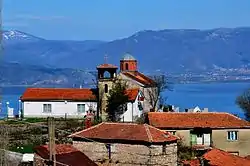Mali Vlaj
Mali Vlaj (Macedonian: Мали Влај) is a village in the municipality of Struga, North Macedonia.
Mali Vlaj | |
|---|---|
Village | |
| Мали Влај | |
 St. Nicholas Church of Mali Vlaj | |
 Mali Vlaj Location within North Macedonia | |
| Coordinates: 41°07′09″N 20°36′56″E | |
| Country | |
| Region | |
| Municipality | |
| Elevation | 857 m (2,812 ft) |
| Population (2002) | |
| • Total | 71 |
| Time zone | UTC+1 (CET) |
| • Summer (DST) | UTC+2 (CEST) |
| Area code(s) | +38946 |
| Car plates | SU |
| Website | . |
Name
The toponym is first recorded as a plural in the name Frougovi Vlasi.[1] The form Vlaj is an old accusative occurring as a plural in Vlahy> Vlahi> Vlai> Vlaj and these forms stemmed from Vla(s)hci meaning residents from the village Vlas(c)i.[1] The c sound in Vlahci was assimilated over time becoming Vlaj and the toponym is related to Vlachs.[1] With the loss of the grammatical case in the Macedonian language, the toponym Vlaj was no longer understood in the plural, instead in the singular.[1] The adjective Мали/Mali meaning "small" contained in the names of some villages is usually used if there is an opposition to a larger settlement with the word Голем/Golem meaning "big" or in toponyms without an additive.[1] Nearby there is no appropriate toponym with the adjective "large" in modern times, yet it is possible that this settlement is in opposition to the village Rëmenj on the Albanian side of Lake Ohrid meaning Vlachs (Aromanians).[1] In the Albanian language, Mali Vlaj is known by the forms Ërmas and Ermëz, meaning Vlachs.[1][2]
History
During the mid-fourteenth century, a document of Serbian Tsar Stefan Dušan refers to property of St Clement church in Ohrid with the settlement recorded under the name Frugovi Vlasi, which later possibly broke up into two villages identified as being modern Mali Vlaj and nearby Frangovo.[3] Local traditions in the Struga area refer to the residents of Mali Vlaj as originating from Rëmenj, Albania arriving in the late eighteenth century.[3] Modern Mali Vlaj is without an Aromanian population though the Aromanian inhabitants of nearby Gorna Belica and Dolna Belica remember that once the village was populated by Aromanians.[3]
Demographics
Mali Vlaj was inhabited by Aromanians, belonging to the Frashëriot subgroup that originated from Albania and became assimilated during the course of the 19th century.[4] The Vevčani-Radožda dialect of the Macedonian language is spoken in Mali Vlaj, that also contains some lexical differences distinguishing it from the speech of neighbouring Vevčani and Radožda.[5]
According to the 2002 census, the village had a total of 71 inhabitants.[6] Ethnic groups in the village include:[6]
- Macedonians 71
References
- Włodzimierz, Pianka (1970). Toponomastikata na Ohridsko-Prespanskiot bazen. Institut za makedonski jazik "Krste Misirkov". p. 70. "На албански селото се вика Ърмас (Ërmas) -'Власи'.... Топонимов е примарен, рамен на етноним во множина, (Фроугови Власи). Формата Влај е стар акузатив во множина, (*Vlaxy > Vlaxi > Vlai > Vlaj). Влашци означувало 'жители на с. Власи' (*Vlaxьci), додекаодликот Власци има с или по пат на асимилација до ц, или пак по аналогија до Власи. Обликот Влај асимилација до ц, прави, или пак по аналогија до Власи. Обликот Влај по губењето на падежната система во мак. јазик не бил веќе сфаќан како плурален, затоа почнал да се чувствува како еднина. Придавката Мали при имињата на селата се употребува обично ако има опозиција со Голем или со 0 (топоним без додаток). Во близината нема никаде соодветен топоним со придавката голем, но возможно е спротивставување на името на с. Р'м'н (спор. с. 112).", p. 112. "'Р'м'н било христ. мусл. село. Jaranov го белези како Ръмънъ, а К'нчов како ифля. Првото на аром., а второто на тур. значи 'Власи'. Така овај назив е во врска со името на. с. Мали Влај во Охридски Дримкол на западниот брег на Охридското Езеро и ја објаснува придавката Мали кај последниов."
- Murtishi, Kaim (2001). Ladorishti: Histori dhe Tradita. Asdreni. p. 47. "Ermëz"
- Koukoudis, Asterios (2003). The Vlachs: Metropolis and Diaspora. Thessaloniki: Zitros Publications. ISBN 9789607760869. p. 423. "Some two centuries later, in the mid-fourteenth century, a resolution of the Serbian Tsar Stefan Dušan regarding the property of the Church of St Clement in Ohrid mention the existence of what was probably a Vlach settlement by the name of Frugovi Vlasi. It probably broke up later on, but may be identified with the modern villages of Frangovo and Mali Vlaj south-west of Struga."; p. 424. "According to local traditions, the ancestors of the inhabitants of Mali Vlaj came from the village of Rrëmenj near Podgradec, possibly at the end of the eighteenth century. However, other traditions relate that, when Moschopolis was in a state of collapse (1769/88), Rrëmenj was a temporary stopping place for Vlach refugees on their way to Gorna and Dolna Belica a little further north. In fact, the name Rrëmenj may itself denote that the village was established by Vlachs or at least that Vlachs stayed there for a time. There are no Vlachs in Frangovo and Mali Vlaj today, though until recently the Vlach residents of Gorna and Dolna Belica still recalled that Mali Vlaj was once inhabited by Vlachs."
- Kahl, Thede (1999). Ethnizität und räumliche Verbreitung der Aromunen in Südosteuropa. Universität Münster: Institut für Geographie der Westfälischen Wilhelms. ISBN 3-9803935-7-7. p. 133. R. Rrămăn (Aromunen mit der Eigenbezeichnung Rrămăn = Farscheroten, Arvanitovlachen)"; p. 147. "Mali Vlaj.... R aus Albanien, bereits im 19. Jh. assimiliert."
- Hendriks, P. (1976). The Radožda-Vevčani Dialect of Macedonian: Structure, Texts, Lexicon. John Benjamins Publishing. p. 17. ISBN 9789031600892.
- Macedonian Census (2002), Book 5 - Total population according to the Ethnic Affiliation, Mother Tongue and Religion, The State Statistical Office, Skopje, 2002, p. 181.
See also
External links
| Wikimedia Commons has media related to Mali Vlaj. |